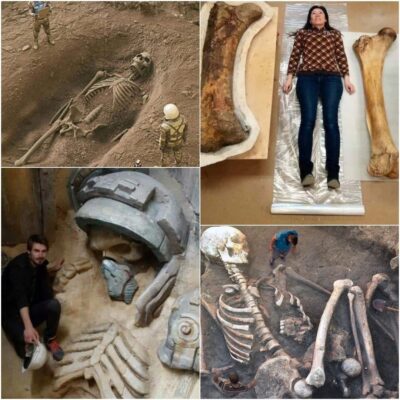A new study found that fine gold wires held an aristocratic French woman’s teeth in place at the turn of the 17th century.

The woman was suffering an inflammation of the gums and bones. Credit: Journal of Archaeological Science: Reports/Rozenn Colleter
At the turn of the 17th century, an aristocratic woman at the height of French society preserved her alluring smile by having her teeth secured with gold wires – a painful procedure that may have made her condition worse.
The remains of Anne d’Alègre, who lived between 1565 until 1619, were discovered during archaeological excavations at the Chateau de Laval in northeastern France in 1988.
She’d been embalmed and buried in a lead coffin, so her bones — and teeth — were remarkably well preserved.

X-ray photographs of the skeleton’s jaws and teeth. Credit: Journal of Archaeological Science: Reports/Rozenn Colleter
Archaeologists discovered a false tooth and ligatures (a medical term for a thread or wire used to tie something) to the teeth during the 1988 excavations, said Rozenn Colleter, an archaeologist at the National Institute for Preventive Archaeological Research (INRAP) in Rennes, France. However, she told Live Science in an email that the nature and scope of the dentistry was not revealed until a reanalysis of the remains last year.
Colleter is the lead author of new research on Anne d’Alègre’s teeth, which was published in the Journal of Archaeological Science: Reports on January 24. The renalysis involved scanning the skull using a “cone beam,” which uses X-rays to create a three-dimensional image.
That scan revealed that d’Alègre suffered from a severe periodontal disease that had loosened many of her teeth — and that she’d had fine gold wires put in place to keep them from falling out.
The wires were often wrapped around the bottom of d’Alègre’s teeth, near the gums. However, some of her teeth had been pierced for the wires to pass through, and she also wore a false tooth made of ivory from an elephant’s tusk.
Although securing teeth by piercing them with wires now may sound primitive, it was advanced dental technology at the time. “This is an innovative treatment”, Colleter said.

Credit: Rozenn Colleter, INRAP
But such a treatment would have been painful, and would have required the wires to be retightened periodically, Colleter said. The dentistry, however, only made the situation worse by destabilizing her neighboring teeth.
So why did d’Alègre endure such a torturous treatment? Colleter suggested that d’Alègre may have felt social pressure to preserve her teeth at a time when the perceived value and rank of women in high society was influenced by their appearance.
Colleter noted that a nice smile may have been particularly important for D’Alègre, who was a twice-widowed socialite. “Beyond a medical treatment, the objective was certainly aesthetic and especially societal,” Colleter said.
D’Alègre’s problem teeth reflect her stressful life. She was a Protestant, or Huguenot, at the time of the French Wars of Religion with the Roman Catholic majority, and she’d been widowed before she was 21 years old.
Her property was seized, and she had to hide from Catholic forces during France’s Eighth War of Religion from 1585 until 1589. Her son Guy was killed at the age of 20 while fighting in Hungary. D’Alègre married again but was widowed again, and she died at age 54 from an unknown illness.

Anne d’Alègre lived an often difficult life between 1565 and 1619. Credit: Public domain
Sharon DeWitte, a biological anthropologist at the University of South Carolina who wasn’t involved in the study, said she found the research paper “fascinating.”
“The authors have rich historical evidence to contextualize their analysis,” she told Live Science in an email. “Work like this improves our understanding of the compromises people made in the past between health and societal expectations.”
DeWitte also noted that periodontal disease can serve as a marker of general health in past populations, because the incidence of such diseases can vary among people based on their experience of stress, nutrition and other factors, she said.
Provided by Live Science. Note: Content may be edited for length, style and clarity. More information: Colleter, R., et al, (2023). Dental care of Anne d’Alègre (1565–1619, Laval, France). Between therapeutic reason and aesthetic evidence, the place of the social and the medical in the care in modern period. Journal of Archaeological Science: Reports, 103794. doi:10.1016/j.jasrep.2022.103794











